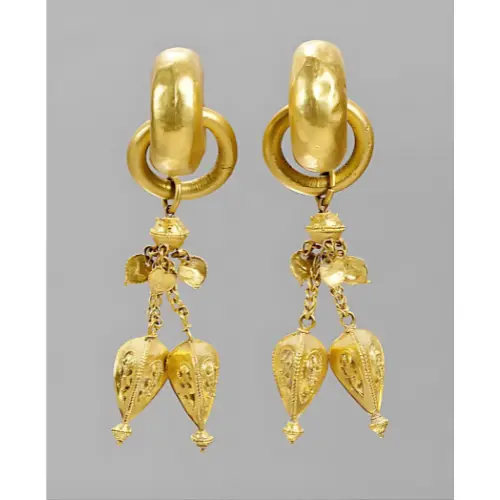
Aztec jewelry, renowned for its intricate designs and vibrant colors, offers a fascinating glimpse into the culture, beliefs, and artistry of one of the most powerful civilizations in pre-Columbian America. The Aztecs, who flourished in central Mexico from the 14th to the 16th century, adorned themselves with exquisite pieces that were not merely decorative but also deeply symbolic. This blog delves into the materials, craftsmanship, cultural significance, and enduring legacy of Aztec jewelry.
Materials and Craftsmanship

Precious Metals and Stones
The Aztecs were master metalworkers, primarily using gold, silver, and copper to create their jewelry. Gold, in particular, was highly prized for its association with the sun god, Huitzilopochtli. In addition to metals, they incorporated a variety of precious and semi-precious stones, such as jade, turquoise, and obsidian. These materials were chosen not only for their beauty but also for their symbolic meanings.
Techniques
Aztec jewelers employed a range of sophisticated techniques, including casting, hammering, and engraving. Lost-wax casting was a common method, allowing artisans to create detailed and complex designs. Hammering thin sheets of metal into shapes and engraving intricate patterns were also standard practices. The craftsmanship demonstrated in Aztec jewelry reflects a high level of skill and an understanding of advanced metallurgical techniques.
Cultural Significance

Social Status and Power
Jewelry in Aztec society was a powerful indicator of social status and political power. Nobles and warriors wore elaborate pieces to display their rank and achievements. The more elaborate and ornate the jewelry, the higher the wearer's status. Common people, on the other hand, wore simpler adornments, often made from bone or clay.
Religious Symbolism
Aztec jewelry was rich in religious symbolism. Many pieces featured motifs related to gods, animals, and nature. For instance, the eagle, a symbol of the sun and a representation of the warrior class, was a common motif. Jewelry was also used in religious ceremonies and rituals, serving as offerings to gods or as part of the attire worn by priests during sacred rites.
Daily Life and Rituals
Jewelry was an integral part of daily life and special occasions in Aztec culture. It was worn during festivals, battles, and rituals. Certain pieces had specific functions, such as nose rings and ear spools, which were worn by both men and women. These items were not just for adornment but also played a role in the ritualistic and ceremonial aspects of Aztec life.
Iconic Pieces
Pectorals and Necklaces

Pectorals and necklaces were prominent in Aztec jewelry, often made from gold and adorned with intricate carvings and precious stones. These pieces were worn by the elite and served as a display of wealth and power.
Aztec nobility wore necklaces made of small gold beads shaped like animals, such as shells, turtles, and frogs. These creatures symbolized water, rain, and fertility, as frogs and turtles lay numerous eggs and adopt a birthing posture. Each ornament, cast using the lost-wax process, had a unique clay mold broken after use, resulting in slight variations in size and detail. Many of these ornaments were discovered in Chiapas, southern Mexico. Gold objects from ancient Mexico are often attributed to the Mixtecs, contemporaries of the Aztecs, known for their exceptional craftsmanship, particularly in Oaxaca. The distinction between Mixtec and Aztec gold artifacts is challenging since few pieces survive from the Spanish conquest.
Ear Spools and Nose Rings

Ear spools, large decorative plugs worn in stretched earlobes, and nose rings were popular among the Aztecs. These pieces were made from various materials, including gold, jade, and turquoise, and were often inlaid with intricate designs.
Bracelets and Anklets
Bracelets and anklets, often crafted from gold and silver, were also common. These pieces were sometimes engraved with religious symbols or adorned with small bells that jingled with movement, adding an auditory element to the visual splendor.
The Legacy of Aztec Jewelry
Influence on Modern Design
The influence of Aztec jewelry can still be seen in contemporary design. Modern jewelers often draw inspiration from the bold designs, vibrant colors, and symbolic motifs of Aztec pieces. This enduring legacy speaks to the timeless appeal of Aztec artistry.
Preservation and Study
Many original pieces of Aztec jewelry have been preserved in museums and private collections around the world. These artifacts provide invaluable insights into the culture and craftsmanship of the Aztecs. Scholars and enthusiasts continue to study these pieces, uncovering new information about the techniques and symbolism employed by Aztec artisans.
Cultural Heritage
For the descendants of the Aztecs and people of Mexico, Aztec jewelry represents an important cultural heritage. It is a reminder of a rich and complex history, a source of pride, and an inspiration for cultural and artistic expression.
Aztec jewelry is a testament to the ingenuity, creativity, and cultural richness of the Aztec civilization. Each piece tells a story, offering a glimpse into the values, beliefs, and daily life of the people who created and wore them. Whether viewed as artifacts of historical significance or as sources of artistic inspiration, Aztec jewelry continues to captivate and inspire, bridging the past and the present with its enduring beauty and profound symbolism.







